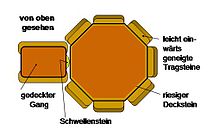Ballegård dolmen
The Dolmen of Ballegård (also known as transition grave hereinafter) is about 0.5 km northeast of Assens / Mariagerfjord , near the Mariagerfjord in Denmark . Neolithic monuments are an expression of the culture and ideology of Neolithic societies. Their origin and function are considered to be the hallmarks of social development.
The polygonal dolmen built in the Neolithic (3500–2800 BC) by the carriers of the funnel beaker culture (TBK) is no longer covered by its mound. The interior 2.5 × 4.0 m chamber was originally built from nine large megaliths that are up to 1.8 m high on the west side. One of the dolmen's bearing stones is missing. The chamber is covered by a huge capstone characteristic of the type. On the east side there is an unusually long corridor measuring five meters for a dolmen. He has three stones on one side and four on the other. The capstones of the corridor are missing.
See also
literature
- Ingrid Falktoft Anderson: Vejviser til Danmarks oldtid. 2nd Edition. Gads Forlag, Århus 1994, ISBN 87-89531-10-8 , p. 157 ff.
Individual evidence
- ^ Johannes Müller : Neolithic Monuments and Neolithic Societies. In: Hans-Jürgen Beier , Erich Claßen, Thomas Doppler, Britta Ramminger (eds.): Varia neolithica VI. Neolithic Monuments and Neolithic Societies. Contributions from the meeting of the Neolithic Working Group during the annual meeting of the North-West German Association for Ancient Research in Schleswig, 9. – 10. October 2007 (= contributions to the prehistory and early history of Central Europe. Vol. 56). Beier & Beran, Langenweißbach 2009, ISBN 978-3-941171-28-2 , pp. 7-16, here p. 15.
Coordinates: 56 ° 40 ′ 44.3 " N , 10 ° 4 ′ 50.3" E
